Efficient reading and writing with AWS S3
12 Feb 2025Back in January 2024 I wrote a post about efficiently writing to S3 in Python that has become relatively popular on this blog (thanks to GoatCounter for revealing this.) So I thought I’d take a broader look at the most efficient ways to read and write from S3 with special attention paid to AWS Lambdas and resource-constrained containers in general.
I won’t be giving detailed code examples in this post as I want to focus on general best practices for reading and writing data in S3 efficiently.
GetObject and PutObject
First off it’s worth addressing the simplest ways of reading and writing to S3, GetObject and PutObject.
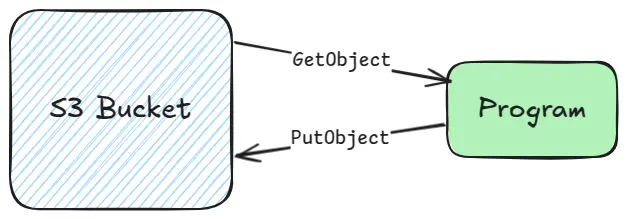
Both are perfectly adequate in most scenarios. Whatever programming language you are using will likely have language bindings for both of these API endpoints, be it Python, Java, Rust, Go or JavaScript.
GetObject will return the whole object to you via a HTTP request, with the
body of the response being the contents of the object. Likewise PutObject
expects the body of your request to be the object you’d like to upload.
There are performance considerations you can make with just these two operations.
For starters, if you can, you should stream the contents of GetObject through
your program. As an example, in Java based languages the API provides you with
a kind of
InputStream,
which means you can use the full range of classes and wrappers for
InputStream instances, including an
InputStreamReader.
Similarly, in Python the Body of your
get_object
response is streamable. So if what you’re reading is some kind of textual
format you don’t need to load it all into memory all at once.
A good example of this is if you are reading line-separated JSON, that is each line in the object represents a whole JSON object. You can stream each line and process it line by line in your program rather than loading the whole file into memory. Other row based data formats like CSV or Apache Avro are also prime targets for this kind of optimised reading technique.
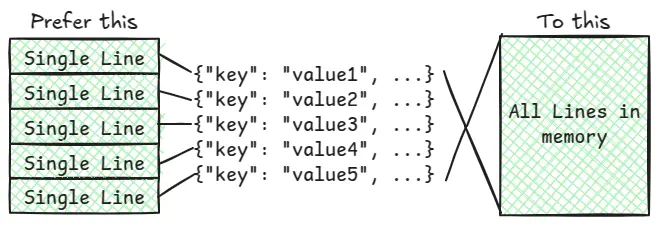
With PutObject you can make use of the temporary storage available to the
container your code is running in. In AWS Lambda this is known as ephemeral
storage
and is configurable separate to the memory of your Lambda instances. Instead of
keeping a large object in memory, you simply write out to the temporary storage
then perform a PutObject using that file. Most of the AWS libraries support
this simple process, and while it means you write twice, once locally and once
to S3, it’s by far the simplest way of avoiding keeping a large object in
memory.
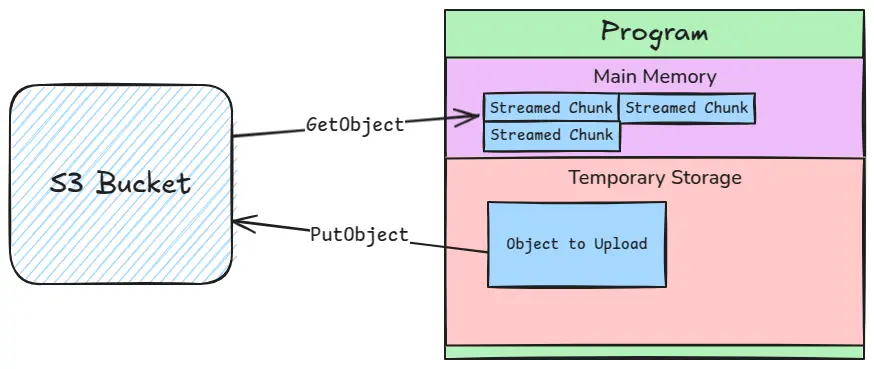
Multipart Uploads
While using PutObject with a temporary file is very easy, you might want to
go a step further if you’re short on temporary storage, don’t want to touch it
all, or know you’ll be uploading very large objects that you don’t want to
incur the cost of writing the data twice. For this you can use Multipart
upload.
Multipart upload lets you upload a single S3 Object in many smaller parts and it’s suggested for uploading of objects that are 100 MB or larger.
Multipart uploads require several network requests but there are benefits to this, namely that, on stable high-bandwidth connections, you can benefit from uploading multiple parts of a large object simultaneously, and, on spottier networks, you only need to retry the parts that fail to upload.
A downside of multipart uploads is that you cannot add any custom metadata to an object being uploaded after the upload has begun. This means that, for example, if you are generating a count of results based on some computation that is ongoing, you cannot tag the S3 object with that metadata when it completes.
Multipart uploads can have a maximum of 10,000 parts, with each part having a maximum size of 5GiB. Up to date limits can be read here, but as of time of writing a single S3 object can be up to 5 TiB in size.
Aside from the last part (which can also be the only part), each part must be
at least 5 MiB in size. This means that your program needs at least 5 MiB of
free memory to properly make use of multipart uploads. If your resources are so
constrained that you don’t have 5 MiB to spare, you should opt for PutObject
and use your temporary storage for large file uploads.
To perform multipart uploads, you first need to call
CreateMultipartUpload
with the bucket and key you want to upload to. You will then get a response
containing an UploadId to use. Next you will upload each part with
UploadPart,
using the correct UploadId and part numbers. Finally you call
CompleteMultipartUpload.
Of course, things can go wrong with multipart uploads so you can use
AbortMultipartUpload
to abort the upload, but be sure to read the caveats associate with this in
regards to ongoing uploads.

If you want to use as little memory as possible in your program and know that your uploaded file is going to be less than 48.82 GiB (i.e. 50,000 MiB), you should upload parts of the minimum 5 MiB size. Even if what you are uploading is less 100 MiB this will allow your program to only store roughly 5 MiB of data to upload at any one time.
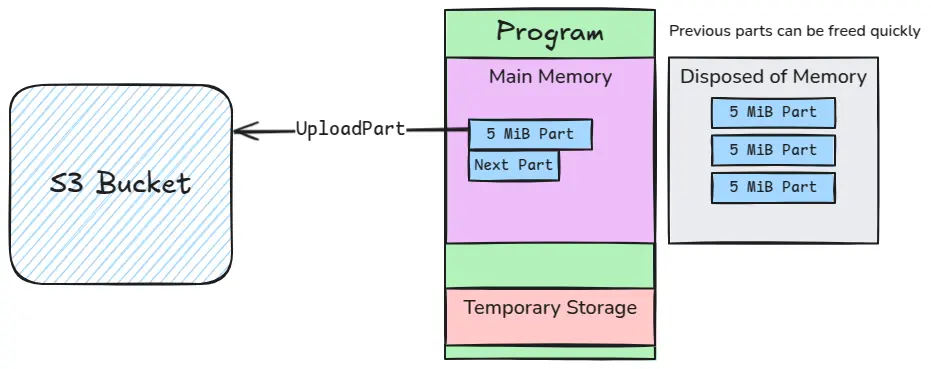
Something else you can do with multipart uploads is use existing S3 objects, or even parts of them, as part of your upload by using UploadPartCopy. This can be useful if you are combining objects, sampling them or extracting the headers out of them.
Combining it all together
For a memory efficient program that both reads and writes to S3 you probably want to be both reading data via streaming and writing data via some kind of streaming mechanism like a multipart upload at the same time. However, exactly how you achieve this will heavily depend on the container of your code.
Efficient Lambdas
For an efficient AWS Lambda, your choice depends on what resources you are willing to commit to each Lambda instance and the size of objects it will be reading and writing.
Small S3 Objects
If you’re only ever writing small S3 objects, that is those under 100 MiB, and
will be reading similarly sized objects, you can likely forgo multipart upload
logic and make use of ephemeral storage space and use a simple GetObject (with
streaming logic if possible) and PutObject based approach. This would let you
use less main memory in your overall Lambda and keep the invocations cheaper.
This will work especially well if your Lambdas only need under 512 MiB of
ephemeral storage space as that is provided at no cost by AWS.
If you really want to reduce the memory consumption of your Lambda, and what you’re implementing can be done in a streaming fashion, you should use a multipart upload approach, even if the S3 objects will still be relatively small (at least 15 MiB big). This allows you to not incur any extra costs for ephemeral storage, provided you can spare at least 5 more MiB of memory for each Lambda.
Larger S3 Objects
You should also use the above approach when dealing with larger S3 objects, but can tune your part sizes above the 5 MiB minimum depending on how much larger the objects are, how well your lambdas perform and how much memory you are willing to give each Lambda instance. A good tool for tuning the latter is aws-lambda-power-tuning, and you could go a step further and graph similar tests for tuning the part sizes.
Language Choice
Lastly, if you want to squeeze the most performance out of your Lambdas you should really consider what programming language your code is written in. Unfortunately, languages like Python, Java and C# have much higher overheads thanks to their runtime environments. A large issue with these languages is Cold Starts-when a Lambda instance is first created. This is because a Cold Start requires the runtime environment to be setup. Luckily, AWS have something called Lambda SnapStart that can alleviate this issue, unfortunately, SnapStart doesn’t work with ephemeral storage sizes above 512 MiB.
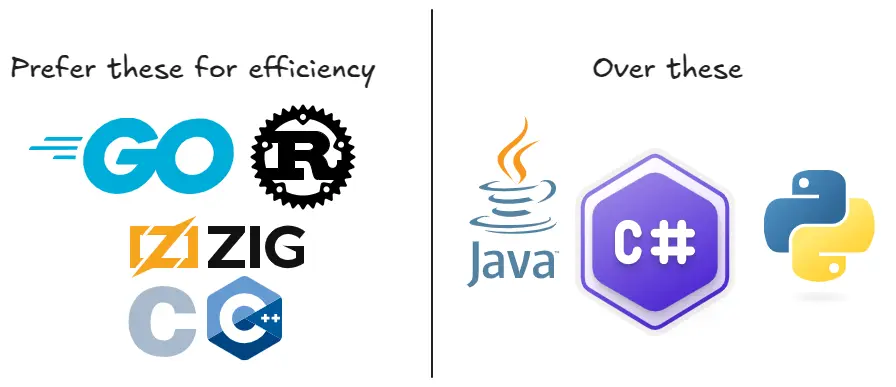
For the most efficient Lambdas you should be looking into using compiled languages like Go and Rust or using some other language that can be run with the OS-only Lambda runtime (like C, C++, or even Zig). The reason for this is the same reason compiled code normally outperforms virtual machine based or interpreted code, it runs directly on the hardware. The binaries produced by these languages will often be much smaller in size and memory footprint than the most optimised VM based language. In the case of Rust, no garbage collection is done so memory is freed as soon as possible, but even with garbage collection in Go you’ll still see much faster Lambdas than the likes of C# and Java thanks to the compiled nature of the code.
I would caution against rewriting all your Lambdas into a compiled language though, especially into Rust. As the time and memory saved may not be worth it in terms of learning, debugging and supporting an unfamiliar language. Using SnapStart and following the best practices will get you a long way even in one of the less efficient languages.
Lambda Running Time
When writing Lambdas you need to be aware of how long your individual invocations will run for since AWS limits each invocation to a maximum of 15 minutes. This post is primarily about reading and writing from S3 so I won’t go into too much detail about working within this restriction, but the main way to do this is to keep your Lambdas lean. Make sure they are performing the smallest possible action while remaining idempotent and atomic. When it comes to S3, that tends to mean your Lambda should ideally be reading a single S3 object and/or writing a single S3 object. If you find your Lambda needs to read and write many S3 objects you may want to split it.
Big-O
You should think of this in terms similar to Big O
notation when it comes to the number of S3
objects being read and written. Specifically, your Lambda code should generally
be O(1) if possible or O(n) if not. Reading and/or writing single S3
objects is the ideal.
The above diagram is a reminder that once you move beyond O(n) small
increases can drastically increase computation.
Conclusion
To summarise, the most efficient way to read and write to S3 heavily depends on the specific constraints of the container of your program such as main memory, local storage, processing power, and time limits.
You should:
- Prefer streaming reads when possible, so you aren’t holding large objects in memory
- Offload to temporary storage for writes to avoid holding data that you are done processing in memory
- Leverage multipart uploads for large uploads and to avoid holding onto data in both main memory and local storage
- Keep your lambdas lean and their operations efficient
- Optimise your choice of language for writing Lambdas, if possible, or use best practices and features like SnapStart to reduce the impact of your language runtime.
While trying to follow these steps, you should be pragmatic. The most optimal decision isn’t always the most memory- or operation-efficient; often, it depends on your expertise and non-functional requirements.
You should also benchmark your approaches to identify bottlenecks and their impact on efficiency. Collecting such metrics will save you time in the long run, as code often only needs to reach a ‘good enough’ state rather than perfection.
Ultimately, efficiently reading and writing to S3 requires understanding how your program interacts with data- its access patterns, memory usage, and constraints. By modeling these behaviors and applying the right techniques, you can significantly improve performance and resource efficiency. Experiment with different configurations, benchmark your approach, and refine your implementation to find what works best for your use case.


Comments